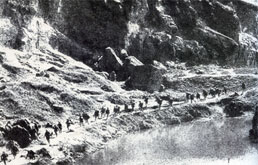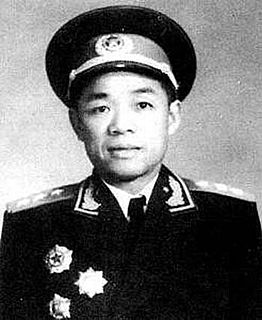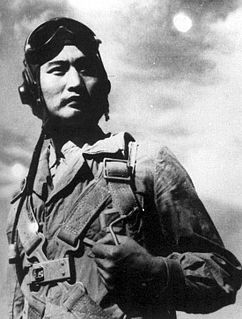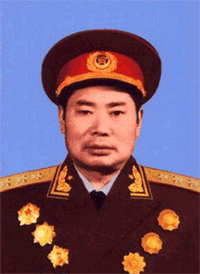This page is based on this
Wikipedia article Text is available under the
CC BY-SA 4.0 license; additional terms may apply.
Images, videos and audio are available under their respective licenses.

Pingxing Pass is a mountain pass in the Shanxi Province of China.
The Japanese offensive called 太原作戦 or the Battle of Taiyuan was a major battle fought between China and Japan named for Taiyuan, which lay in the 2nd Military Region. This battle concluded in loss for the NRA, including part of Suiyuan, most of Shanxi and their most modern arsenal at Taiyuan and effectively ended large-scale regular resistance in the North China area.

The Battle of Xinkou was a decisive engagement of the Taiyuan Campaign, the second of the 22 major engagements between the National Revolutionary Army and Imperial Japanese Army during the Second Sino-Japanese War.
The following units and commanders fought in the Defense of the Great Wall of the Second Sino-Japanese War. List as of 20 March 1933.
Order of battle Peiking – Suiyuan Railway Operation refers to the troops involved in the 1937 Peiking – Suiyuan Railway Operation.
The Japanese and Manchukuoan order of battle for Operation Nekka was:
The Battle of Changsha (1939) was an unsuccessful attempt by Japan to take the city of Changsha, China, during the second Sino-Japanese War.

The Battle of Wanjialing, known in Chinese text as the Victory of Wanjialing, refers to the Chinese Army's successful engagement during the Wuhan theatre of the Second Sino-Japanese War against the Japanese 101st, 106th, 9th and 27th divisions around the Wanjialing region in 1938. The two and a half month battle resulted in heavy losses of the Japanese 101st and 106th Divisions.

Han Xianchu was a general of the Chinese Communist Party. Han participated in many military campaigns and battles such as Battle of Pingxingguan, Liaoshen Campaign, Pingjin Campaign, Hainan Campaign, and the Korean War. In 1955 he was among the first group of military leaders to be awarded the Shang Jiang rank.
The 82nd Group Army, formerly the 38th Group Army, is a military formation of China's People's Liberation Army and one of three active group armies belonging to the Beijing Military Region. It is based at Baoding, Hebei and is composed of three heavy combined arms brigades, two medium combined arms brigades, a light combined arms brigade, a special operation brigade, an army aviation brigade, an artillery brigade, an air-defense brigde, an engineer and chemical brigade and a sustainment brigade in addition to various support and logistics units. Its unit ID number is 66393.
The Order of Battle Peiking–Hankou Railway Operation
Order of Battle Tianjin–Pukou Railway Operation
Order of battle for the Battle of Taiyuan in the Second Sino-Japanese War.

The Hundred Regiments Offensive was a major campaign of the Communist Party of China's National Revolutionary Army divisions commanded by Peng Dehuai against the Imperial Japanese Army in Central China. The battle had long been the focus of propaganda in the history of Chinese Communist Party but had become Peng Dehuai's "crime" during the Cultural Revolution. Certain issues regarding its launching and consequences are still controversial.

Liu Yudi was a MiG-15 pilot of the People's Liberation Army Air Force of China, and a flying ace during the Korean War, with 6 victories. He later served as Commander of the Beijing Military Region Air Force, and was awarded the rank of lieutenant general in 1988.
The 7th Division (1st Formation) of the Chinese People's Liberation Army was created in February 1949 under the Regulation of the Redesignations of All Organizations and Units of the Army, issued by Central Military Commission on November 1, 1948, basing on the 2nd Independent Brigade, 3rd Column of the PLA Northwestern Field Army. Its history can be traced to the 358th Brigade(2nd Formation), 120th Division of Eighth Route Army, formed in April 1939.
The 145th Division was created in November 1948 under the Regulation of the Redesignations of All Organizations and Units of the Army, issued by Central Military Commission on November 1, 1948, basing on the 34th Division, 12th Column of the PLA Northeastern Field Army. Its history can be traced to Eastern Harbin Security Command, formed in September 1945.

Liu Zhen , or Liu You'an (刘幼安), was a general in the Chinese People's Liberation Army.
Liu Zhonghua was a Chinese military officer. He was commander and political commissar of the PLA Navy 6th Fleet in 1953, and president of Naval Senior Institute in 1957. In 1955 he was awarded the rank of major general (shaojiang).












